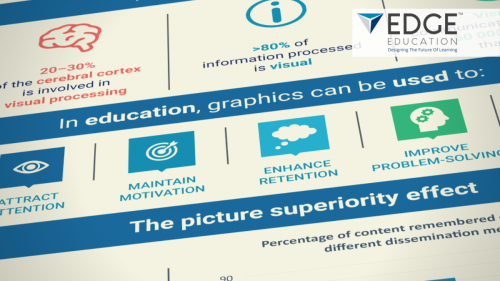In the Digital Age, we’re constantly receiving information in multiple forms – and the same is true for the educational space. As such, it’s vital to understand how the use of media, such as visuals, impacts the learning process. Well-designed educational graphics can increase engagement, foster understanding, and improve the learning experience.
This infographic contains some vital principles to bear in mind when using graphics in education (click infographic to enlarge).
Share this image on your site
Using graphics in education – content
Humans are ‘visually wired’:
- 20-30% of the cerebral cortex is involved in visual processing
- >80% of information processed is visual
- Visuals communicate information 60 000x faster than text
In education, graphics can be used to:
- Attract attention
- Maintain motivation
- Enhance retention
- Improve problem-solving
- Integrate knowledge
The picture superiority effect – using a combination of visual and verbal cues leads to a significant increase in long-term information retention.
Colour visuals increase willingness to read by 80%.
When people need to follow instructions, they do so 323% better when there are illustrations.
Second-language learners struggle with iconography more than first-language learners.
Novice learners benefit more from static diagrams than from animated ones.
Colour matters:
- Red activates a ‘prevention-focused’ mindset and increases caution
- Blue backgrounds can improve information retention
- Strategic colour usage can guide attention and decrease search time
References
Cook, M. P. (2006), ‘Visual Representations in Science Education: The Influence of Prior Knowledge and Cognitive Load Theory on Instructional Design Principles’. Science Education 90: 1073–1091.
Kalyuga, S. (2008), ‘Relative effectiveness of animated and static diagrams: An effect of learner prior knowledge’. Computers in Human Behavior 24(3): 852–861.
Kumi, R., Conway, C. M., Limayem, M. and Goyal, S. (2012), ‘Learning in Color: How Color and Affect Influence Learning Outcomes’. IEEE Transactions
on Professional Communication 56(1): 2–15.
Levie, W. H. and Lentz, R. (1982), ‘Effects of Text Illustrations: A Review of Research’. Educational Communication and Technology 30(4): 195–232.
Van Essen in Sheth, B. R. and Young, R. (2016), ’Two Visual Pathways in Primates Based on Sampling of Space: Exploitation and Exploration of Visual
Information’. Frontiers in Integrative Neuroscience 10: 1–20.
Vogel, D. R., Dickson, G. W. and Lehman, J. A. (1986), ‘Persuasion and the Role of Visual Presentation Support: The UM/3M Study’. Management
Information Systems Research Center: Working paper.
Wilmes, B., Harrington, L., Kohler-Evans, P. and Sumpter, D. (2008), ‘Coming to Our Senses: Incorporating Brain Research Findings into Classroom
Instruction’. Education 128(4): 659–666.
Xerox [website] (2017), ‘20 Ways to Share Color Knowledge’. <https://www.office.xerox.com/latest/COLFS-02UA.PDF> accessed 24 August 2020.


